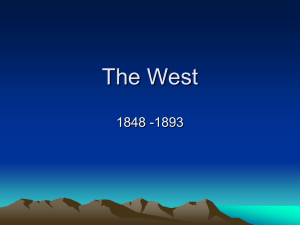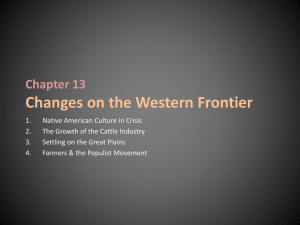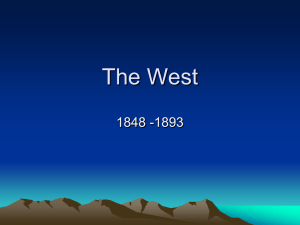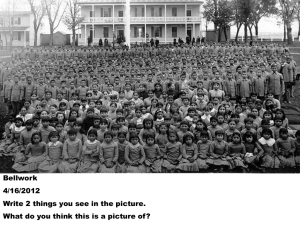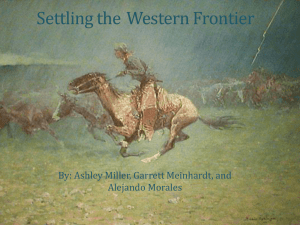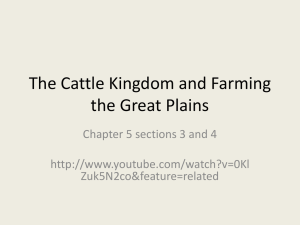Settling the West 1865-1890
advertisement
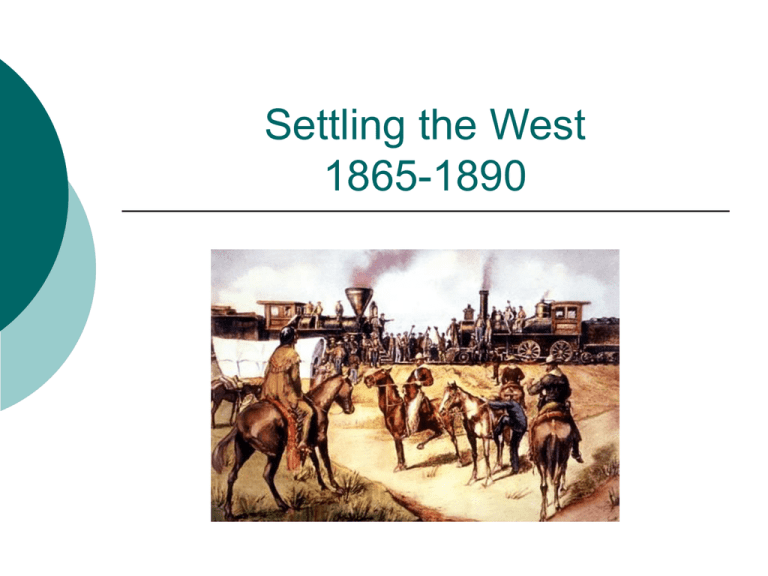
Settling the West 1865-1890 Key Question Why did conflicts arise between Native Americans & the settlers? Miners, ranchers, & farmers took Native Americans’ land & destroyed their source of food (the buffalo). Troubled Relations with the Native Americans Cultural Preservation vs. Prosperity Manifest Destiny – the belief that the U.S. Government & its people had the God given right to own North America from coast to coast. Self – Preservation – the Natives fought to maintain their way of life as settlers poured into their lands. Manifest Destiny An Allegorical Painting by John Gast 1872 Key Question How did Native Americans respond to the loss of land from white settlement of the Great Plains? Some attacked wagon trains & ranches. Many went to war against nearby settlers & the U.S. Army. Troubled Relations with the Natives Reasons for Conflict Pioneer Settlement on the Great Plains Native resistance to the destruction of their culture Broken treaties & promises Revenge on both sides Slaughter of the Buffalo Events of the Native Wars 1850 - 1890 Treaty of Fort Laramie (1851) Plains tribal leaders representing the Sioux, Cheyenne, & Arapaho signed this treaty in Wyoming The treaty established new boundaries for tribal lands to allow for more white settlement Despite the treaty some natives preferred conflict & resisted reservation life. Document-Based Questions Text p. 407 Questions #21-22 Key Question For what reasons did the government’s plans to move the Plains Indians onto reservations fail? The natives preferred life on the Plains. Native leaders were pressured into signing treaties. Reservations were plagued by poverty, despair, & corruption. Events of the Native Wars 1850 - 1890 Sand Creek Massacre (1864) In response to attacks on miners & settlers, Colonel John Chivington attacked a peaceful Cheyenne Village in Colorado More than 150 men, woman, & children were killed Red Cloud’s War Events of the Native Wars 1850 - 1890 Red Cloud’s War (1863 - 1866) Sioux Chief Red Cloud led repeated attacks against miners & settlers traveling along the Bozeman Trail in Montana Second Treaty of Fort Laramie (1868) Little Bighorn Events of the Native Wars 1850 - 1890 Battle of the Little Bighorn (1876) Also known as Custer’s Last Stand Battle of the Little Bighorn Reasons for Battle: Gold is discovered on the Great Sioux Reservation in the Black Hills of South Dakota Thousands of miners & settlers pour into this land, which is a violation of the 1868 Treaty of Fort Laramie The U.S. Government offers to purchase the land, but some Natives refuse The U.S. decides to force the “rebel” natives onto reservations The Battle: Lt. Col. George Custer & his 7th Cavalry were slaughtered by Sitting Bull & Crazy Horse’s Sioux forces Battle of the Little Bighorn The Battle: Lt. Col. George Custer & his 7th Cavalry were slaughtered by Sitting Bull & Crazy Horse’s Sioux forces Significance: Last major victory for the Natives over the U.S. Government News reports to the east did not identify an attack by Custer & his men, but an unnecessary slaughter by the Natives Nez Perce Events of the Native Wars 1850 - 1890 Flight of the Nez Perce (1877) Chief Joseph & his Nez Perce of Washington, Idaho, & Oregon failed to escape to Canada. Federal authorities captured them & they were sent to a reservation in Oklahoma. Events of the Native Wars 1850 - 1890 Apache Wars (1881-1886) Geronimo led a band of Apache in retreat from the U.S. Army throughout the American Southwest Due to disease & starvation the Apache were forced to surrender in 1886. Wounded Knee Events of the Native Wars 1850 - 1890 Massacre at Wounded Knee (1890) In South Dakota, the U.S. Army responded to the “Ghost Dance” Movement by arresting a group of 350 Sioux A disturbance broke out, prompting the soldiers to open fire killing 90 men & 200 women & children. This event brought an end to Native resistance against the U.S. Government Events of the Native Wars 1850 - 1890 Changes in Native Policy Reservation System – the Natives were made “wards” of the government & placed on confined lands Problems Natives faced on Reservations: Forced Assimilation Destruction of their traditional way of life Starvation & Disease Dawes Act (1887) – provided each male head of a Native family 160 acres of reservation land & provided for U.S. citizenship Dawes Act Key Question Why do you think the government’s policy of assimilation of Native Americans was a failure? Native Americans were unwilling or unable to change their way of life. They received no training in farming & their allotments were too small to be profitable “We did not give our country to you; you stole it” Chief Sitting Bull Sioux “It makes my heart sick when I remember all the good words and all the broken promises” Chief Joseph Nez Perce “Once I moved about like the wind. Now I surrender to you and that is all” Geronimo Apache Key Questions For what reasons might Americans have wanted to move west after the Civil War? Both white & African Americans sought new lives & new economic opportunities Key Questions How did the Industrial Revolution & an increase in immigration lead to western settlement? The industrial revolution and immigration caused unemployment in the east. Machines were taking jobs from workers and immigrants were willing to work for very low pay. People moved west to start a new life and get a new job. Key Questions What economic opportunities drew large numbers of people to the Great Plains? A large amount of people came to the Great Plains for ranching, farming, & mining opportunities. Why did Pioneers move West? After the arrival of the Industrial Revolution in the United States, people began to move west in order for new opportunities to “get rich quick” or to make a living. The West provided new opportunities such as: Working on the Transcontinental Railroad Cattle Ranching Farming Mining Key Questions How did the transcontinental railroad open up the West for settlement? The transcontinental railroad opened the west for settlement because it was faster, cheaper and more reliable form of transportation to carry people back and forth from the east coast to the west coast. Transcontinental Railroad Transcontinental Railroad Transcontinental Railroad It is considered one of the greatest technological achievements in U.S. History. Made it possible for a traveler to complete the trip in five days for $150 Construction began in 1863 The Central Pacific built east from Sacramento, California, while the Union Pacific built west from Omaha, Nebraska Transcontinental Railroad The Transcontinental Railroad was built in six years. Irish & German immigrants, freed slaves, former Civil War soldiers, & especially Chinese immigrants played a role in construction. The railroad led to the division of the nation into four standard time zones. Transcontinental Railroad On May 10, 1869, at Promontory Summit, Utah, a golden spike was driven thus completing the connection of east & west Cattle Ranching Key Questions What was the open range & long drive? An open range was the thousands of miles of unfenced grassland. Herding of cattle across the plains to the cow towns was known as the “Long Drive”. Cattle Ranching & the Long Drive 1870 Text p. 390-391 Analyzing Visuals #1-2 Key Questions How did the growth of railroads and cities impact the cattle business? The railroads brought the cattle cross-country to the open plains and built cow towns there. What does the American cowboy tradition owe to the Mexican vaquero? The American Cowboy tradition owes its clothes, gear and vocabulary to the Mexican Vaquero. Many of the traditions came from the Spanish. Key Questions How did the ordinary cowboy’s life differ from the popular conception of it? In people’s imaginations, a cowboy were thought to be one of the most romantic characters in American history but in reality cowboys lived tough, lonely, and hazardous lives. Their lives revolved around the cattle drive. They let off steam by gambling, drinking, and fighting in cow towns. Many cowboys were not the individuals portrayed by Hollywood. Cattle Kingdom After the Civil War demand for beef increased especially in the east’s rapidly growing cities. Ranchers drove Longhorn cattle from Texas to the railheads of Kansas (1,000 miles), where they would be shipped, slaughtered, & sold. Known as the “Long Drive” Most cowboys were African-American (25%) or Mexican-American (12%). An overabundance of cattle, then harsh winters as well as dry summers doomed the cattle industry in the late 1800s. Cowboys Although the image of cowboys is American, his way of life was adopted directly from Spanish ranchers in Mexico. A cowboy’s clothes, food, & vocabulary were influenced by Mexican Vaqueros. Vaqueros were the first to wear spurs Chaparreras, or leather overalls, became chaps Charqui, or “jerky” – dried strips of meat – were eaten Bronco caballo, or rough horse, was a bronco Mestenos, were mustangs prized by the American Cowboy Rancho became the American Ranch Rodeo was a term borrowed from the Spanish Cowboys Homestead Act Key Questions Describe the Homestead Act and related federal government laws to assist settlers in obtaining western land. Why was 160 acres not adequate? The Homestead Act provided 160 acres of land to any individual willing to move west. Each homesteader was required to live on & improve the land. The Act served two purposes, relief to those struggling in the east & the creation of new markets for eastern goods. Farming the American West 1870-1900 Text p. 395 Analyzing Geography #1-2 Farming Homestead Act (1862) – the U.S. Government encouraged Western settlement by granting 160 acres of land to any citizen or immigrant willing to pay a small fee, live on the land for five years, & make some improvements Homesteading proved to be difficult due to scarce rain on the Great Plains & land too small to be economical. About 1/3rd eventually failed. Key Questions What hardships did farmers face in the late 1800s? Hard soil that was difficult to plow Lack of rain; strong blizzards in the winter. Few trees from which to build shelter; led to sod homes. Locusts ate the farmers crops and trees. Due to dry land farmers would have to buy more land so they could spread out the crops to obtain the nutrients out of the ground. Key Questions What factors helped bring an end to the open range? One of the factors that led to the collapse of the open range was the success of the cattle industry. The main problem was the number of cattle, next being the cold weather and harsh winters, and cattle prices were low at this time. Sheep herders reduced the size of and fenced pastures, then eventually developed new farming methods which brought an end to the open range and farming. Mining Gold & silver discoveries in California, Colorado, & Nevada caused Americans to rush to the West for the chance to strike it rich Boomtowns, a town that has a sudden burst of economic or population growth, sprang up throughout the Northwest. Few prospectors became rich. The most successful large mining companies & those businesses started in the boomtowns. Review Causes of Settlers Moving West to the Great Plains Mining Deposits of gold, silver, & copper were discovered New technologies, such as hydraulic mining, make it possible to remove vast quantities of ore Ranching Wild longhorn cattle, found to survive well on the Plains, are available in large numbers to be rounded up. Railroads provide an easy way to ship cattle to eastern markets. Farming Congress passes the Homestead Act in 1862. New farming technologies, including new plows, reapers, & drills, make it possible to farm on the Plains. Railroads advertise for settlers & bring necessities such as lumber & coal to the Plains. Review Effects of Settling the Great Plains Miners arrive in such large numbers that Colorado, the Dakotas, Nevada, & Montana are able to become states. Hydraulic mining damages the environment in some areas & interferes with farming. The Great Plains becomes the nation’s Wheat Belt, growing tens of thousands of acres of wheat. The arrival of miners, ranchers, & farmers leads to conflict with Native Americans. The federal government fights several wars with the Native Americans, establishes reservations, & passes the Dawes Act to assimilate Native Americans.


